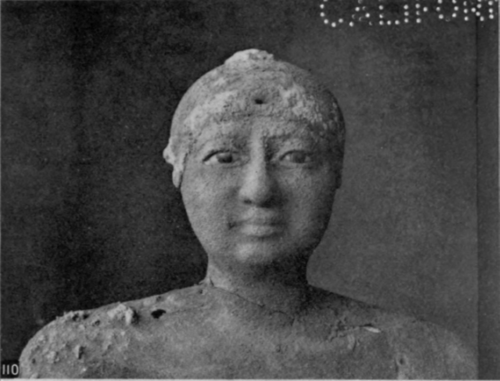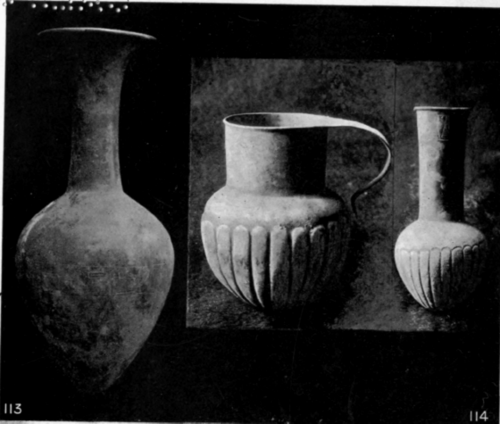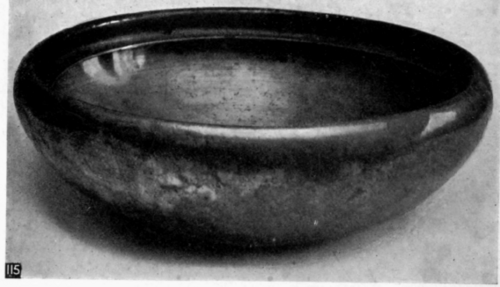Chapter IX. Metal Work
Description
This section is from the book "The Arts And Crafts Of Ancient Egypt", by W. M. Flinders Petrie. Also available from Amazon: The Arts And Crafts Of Ancient Egypt.
Chapter IX. Metal Work
Here we shall deal with the useful metals, apart from the ornamental work of jewellery previously described. Copper was worked from the beginning of the prehistoric civilisation. In one of the earliest graves a little copper pin was found, used to fasten over the shoulders the goat-skin, which was worn before the weaving of linen. Not long after, a small chisel appears, then an adze and harpoon, then needles, and larger sizes of tools come at the close of the prehistoric age. All of this copper was shaped by hammering. Polished stone hammers were used, and the work was so exquisitely regular that a polished surface still remains on an adze, which shows no trace of the method of manufacture; certainly it was not ground. The mode of hammering is shown in some early historical sculptures; a stone hammer was held in the palm of the right hand, which was swung overhead, and brought down on the metal. How such work could be done without hurting the hand by concussion is not clear to us. It is strange that down to Greek times the Egyptians never used a long handle to a hammer.
In the beginning of the kingdom, copper ewers and basins were made; these are known from the sculpture of Narmer, and examples are found in the royal tombs. They were skilfully hammered out, with cast spouts inserted. The main example of early copper-work is the life-size statue of King Pepy, and the smaller figure of his son (fig. no). The trunk and limbs are of hammered copper, riveted together; the face, hands, and feet are cast doubtless by cire perdue. The ease and truth of the whole figure shows that there must have been long practice in the artistic working of copper; yet no traces of such figures are found earlier, nor for over a thousand years later, and we may thus realise how scattered are the points we have, in the view of the art as a whole.
The IXth dynasty has left a coarse example of cast copper tooled with a graver, the brazier of Khety, now in Paris. Of the XI Ith dynasty there is not much copper work, except for tools. The moulds for casting tools were found at Kahun.
They were open moulds, cut out of a thick piece of pottery, and lined smooth with fine clay and ash.
Down to this age copper was used with only small amounts of hardening mixture; after this, bronze of copper and tin came into general use. The earlier copper of the Ist dynasty usually contains one per cent. of bismuth, and later than that one or two per cent. of arsenic, and is "underpoled," in modern terms, that is, a good deal of unreduced oxide of copper is left in the metal. Both of these mixtures harden it; and by strong hammering it is made still harder. Copper so treated at present can be made as hard as mild steel. Thus the metal was fit for the wood-cutting tools, and for the chisels used for cutting limestone. The harder stones were worked with emery.1
Bronze has been found in one case as far back as the IIIrd dynasty, but this was only a chance alloy. It began to be regularly used in the XVIIIth dynasty, 1600 B.C.; and the source of the tin for it is a point of interest in early trade. Cornwall and the Malay States are the only modern sources of importance; but probably other surface sources have been exhausted, as in the case of gold deposits. Now bronze is found in Central Europe about as early as in Egypt, and it is unlikely to have been imported there from Egypt, or to have been traded there as soon as it would be to a great state like Egypt. The presumption would be that it originated about Central Europe. As a district in Saxony is known as Zinnwald, and crystallised oxide of tin is still brought from there and from Bohemia, it is very likely that there may have been stream tin deposits capable of supplying Europe and Egypt.
1 The earlier source of copper was Sinai, where there yet remain thousands of tons of copper slag in the Wady Nasb. In the XVIIIth dynasty and onwards, Cyprus - the Kupros island of copper - came into regular connection with Egypt, and probably supplied most of the metal.
Metal Statuary



110. Merenra (VIth dynasty)
111, 112. Takushet (XXVth dynasty)


113. Bronze pouring vase.
114. Bronze fluted vase.
115. Silver anti-splash bowl.
In the XVIIIth dynasty bronze vessels were wrought very skilfully by hammer-work. The flask (fig. 113) for washing the sandals of Amen, inscribed with the owner's name and titles, is 9 inches high and has a body 4 inches across; it has been hammered on anvils introduced through the neck, which is only 1 1/4 inches wide. By the weight of it (7 ounces) it cannot average more than 1/40th inch in thickness. A general mode of stiffening the thin metal vases was by fluting the surface (fig, 114), a method also used in prehistoric Greece.
The casting of bronze was generally done by the cire perdue method. A core of blackened sand is usually found in the casting. This was probably sand mixed with a little organic matter; as it is never reddened, probably no clay or mud was used. Over the core the wax was modelled, and the traces of the modelling tool can be seen clearly on unfinished bronzes. On an ibis there was a rolled pellet of wax put between the beak and the breast, so as to induce the flow of the metal along the beak; this would be easily cut away in finishing. An example of a kneeling figure shows the legs completely modelled before putting the pleated dress over them, and then the whole was cast. How the core was fixed within the outer mould is a difficult question. On the many unfinished bronzes that I have examined I have never found a definite connection above the base, but only casual blowholes. Yet the metal was often run as thin as 1/50th inch, so that a shift of the core by as little as 1/100th inch would throw the casting out, and make a flaw. How the core was retained so firmly in position against the flotation of the melted metal is not clear. No metal bars were put through the core to steady it, as Cellini did in his large castings. A system was used of stiffening bronze-work by casting it over iron rods; by the free use of iron, this must be of the Greek period. Solid bronze castings come into use in Ptolemaic and Roman work.
Continue to:


